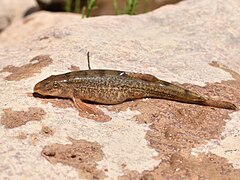Paralongicollum is a genus in Acanthocephala, the thorny-headed worms, also known as spiny-headed worms.
| Paralongicollum | |
|---|---|
| Scientific classification | |
| Domain: | Eukaryota |
| Kingdom: | Animalia |
| Phylum: | Acanthocephala |
| Class: | Palaeacanthocephala |
| Order: | Echinorhynchida |
| Family: | Pomphorhynchidae |
| Genus: | Paralongicollum Amin, Bauer & Sidorov, 1991[1] |
Taxonomy
The genus was described by Amin, Bauer & Sidorov, 1991. The National Center for Biotechnology Information does not indicate that any phylogenetic analysis has been published on any Paralongicollum species that would confirm its position as a unique order in the family Pomphorhynchidae.[2]
Description
Paralongicollum species consist of a proboscis covered in hooks and a trunk.
Species
The genus Paralongicollum contains three species.
Distribution
The distribution of Paralongicollum is determined by that of its hosts.[5]
Hosts

The life cycle of an acanthocephalan consists of three stages beginning when an infective acanthor (development of an egg) is released from the intestines of the definitive host and then ingested by an arthropod, the intermediate host. Although the intermediate hosts of Paralongicollum are arthropods. When the acanthor molts, the second stage called the acanthella begins. This stage involves penetrating the wall of the mesenteron or the intestine of the intermediate host and growing. The final stage is the infective cystacanth which is the larval or juvenile state of an Acanthocephalan, differing from the adult only in size and stage of sexual development. The cystacanths within the intermediate hosts are consumed by the definitive host, usually attaching to the walls of the intestines, and as adults they reproduce sexually in the intestines. The acanthor is passed in the feces of the definitive host and the cycle repeats. There may be paratenic hosts (hosts where parasites infest but do not undergo larval development or sexual reproduction) for Paralongicollum.[8]
Paralongicollum parasitizes animals. There are no reported cases of Paralongicollum infesting humans in the English language medical literature.[7] P. sergenti might be a vector for another parasite in humans.[9]
- Hosts for Paralongicollum species
- The Rainbow trout is a host for P. nemacheili.
- The Tibetan stone loach is a host for P. nemacheili.

